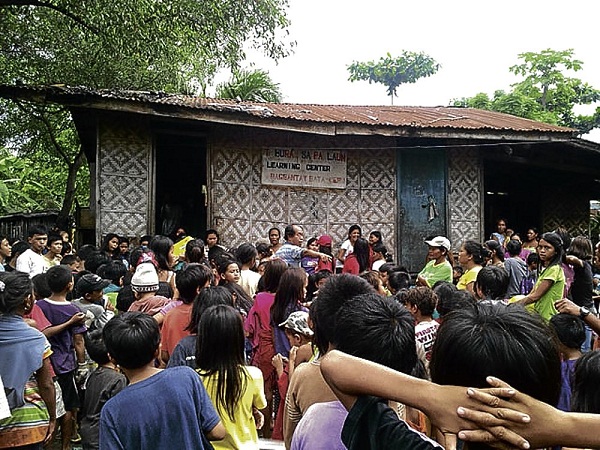Despite closure, Cebu dump still draws children

MEMBERS of Ate-Kuya Children’s Welfare regularly visit the dump in Barangay Inayawan, Cebu City, to conduct storytelling sessions and feeding activities, and to provide hygiene lessons to the children. Photo by CRIS EVERT LATO
CEBU CITY—When the clock strikes 5 p.m. on weekdays, Raymond, Christian and John Lloyd drop their schoolbags at home in Cebu City’s Barangay Inayawan and head for the nearby dump to join their pals—John Paul, Martin and Eman—in looking for tin cans, plastic and other items that can be sold to scrap buyers.
The boys are between
9 and 11 years old, and live with more than 300 families near the dump.
They usually wear slippers when scavenging, but John Lloyd showed up in boots on the day the Inquirer interviewed them. “Kinit-an ra man pud na niya (He just found it in the garbage),” the boys said, laughing,
Life is hard in the neighborhood, they said, especially when a family has at least six members. More family members, more mouths to feed. This does not prevent them, however, from going to school.
Article continues after this advertisementThey wake up early in the morning and go home early, too, so they still have time to “work.” And more time they have on Saturdays and Sundays, when there are no classes. Scavenging has become their way of helping their parents.
Article continues after this advertisement“We are really good at … [scavenging]. Our parents taught us how to check garbage and pick those that can be sold … . We grew up knowing that there is money in garbage,” Raymond, 11, said in Cebuano.
Tin cans are sold at P8 per kilogram and white plastic bags, P3 per kilogram. They give their earnings of between P100 and P300 a day to their parents and are usually rewarded P20, which they use to pay for computer games.
Lucky days
On some days at the dump, they are lucky. They had found a gold bracelet, a silver ring and a mobile phone in the heap, and handed over the items to their parents.
“The most important thing is we can buy food. We need it,” they said.
John Lloyd, 10, said he and his friends thought that their days of scavenging had come to an end when city officials announced in December last year that the dump would be closed.
“We just heard from the adults that maybe we will get hungry because there is no more garbage, but it is not true. The trucks still come although the garbage is not that much,” said Christian, 9, a Grade 3 pupil at Inayawan Elementary School.
During a session of the city council in September last year, landfill manager Randy Navarro said the city yielded 300 tons of garbage daily and that
60 percent of the volume was being brought to Inayawan.
The dump covers 11.73 hec-tares of the entire property area of 15.41 ha. It opened in 1998 and was expected to reach full capacity by 2005.
Full capacity
According to garbage disposal records, full capacity was indeed reached in 2005 with a daily load of 1,360 cubic meters or 450 tons of trash. The facility can hold 938,400 cubic meters of garbage.
It was only in December last year, however, when the city government issued the closure order after a series of consultation meetings with barangay residents. Some scavengers were later hired to sort out garbage in the dump’s materials recovery facility.
Since trucks still come with trash, most of the boys’ parents are still scavenging.
Children, like Eman, do not just see the dump as a source of money; it is also their playground.
Last week, Ate-Kuya Children’s Welfare, a loose organization of friends, conducted a storytelling session and gave gifts to more than 300 families in Inayawan. As the six boys had gone scavenging, they came late but still caught up with the activities near the dilapidated Tinubdan sa Paglaum (Source of Hope) learning center.
The center, which used to receive foreign funding, is run by Al Cane, a retired social action worker involved in church programs. Cane now networks with other groups to help the community.
Arriving before the storytelling ended, Raymund said, “Just in time.”
John Paul then retorted, “We didn’t even hear the entire story. Is there no repeat?”
As if negotiating for prices of tin cans and plastics, he said, “Please come back. You tell us a story, we will take you scavenging.”